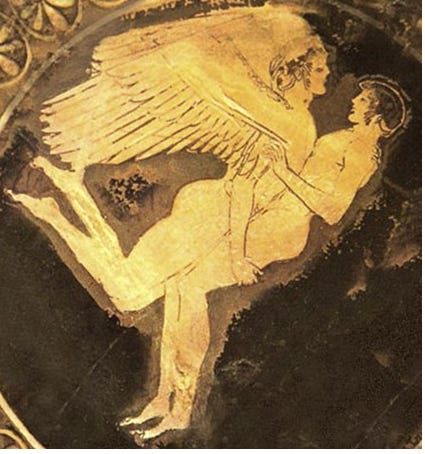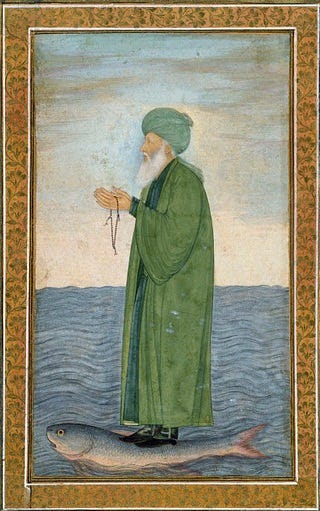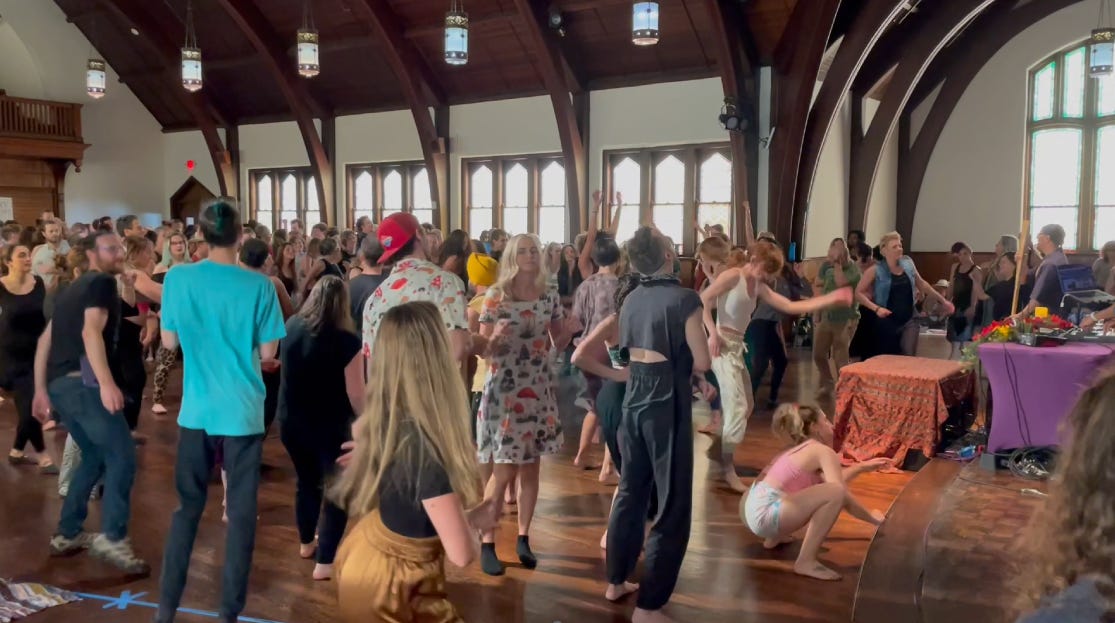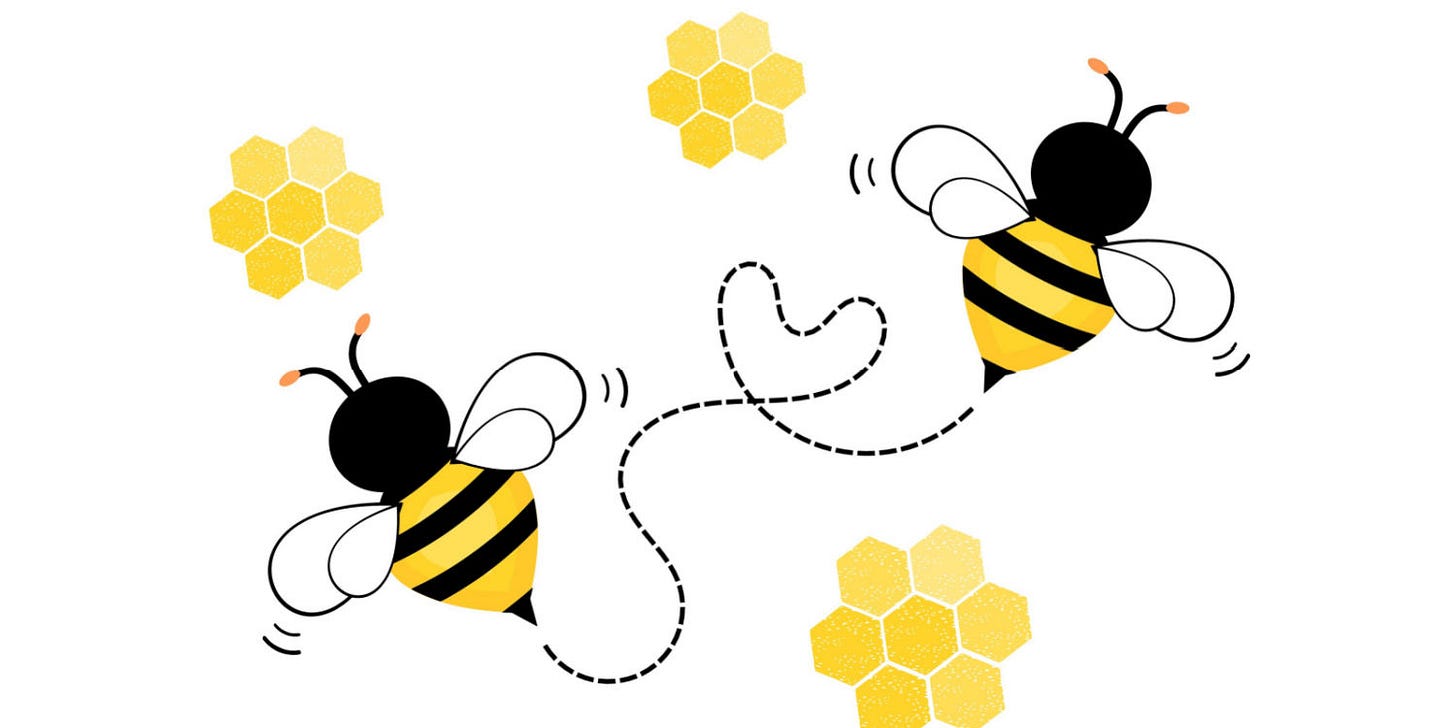I decided not to post this article after the emotional hangover from election night, and now, the morning after, I realize it is perfect.
During the election returns, I was at the airport, waiting in an almost empty parking lot after midnight. A guy came up asking if I had jumper cables. He also had a doggie in his car and commented on mine.
I was on the phone, commiserating with a friend, but said goodbye and got out. I lifted my hood, fumbled to see terminals in the dark, and started his scruffy car so he could go pick up his worried wife.
I didn’t know if he was a Trumper or not.
It occurred to me at that moment that this is how we will survive — by deriving satisfaction and meaning from small acts of connection and caring — aka Bondo. It will be very much in the moment. Handing out love to people we normally pass by because we suffer together.
For the first time, we won’t be glued to the news because we’ve seen this story and know how it turns out.
A perverse gift is being offered: To inquire into the mystery of one’s existence with our fellow human beings.
The oligarchs will live their empty lives thirsting on power while we enjoy the profound richness of humanity.
Here’s the article.
Like most boys, I was a space nerd.
From the moment the Soviets rocketed Laika, a mixed-breed mutt, to be cooked in space (whoops), I was hooked. JFK’s challenge to put a man on the moon by the decade’s end captured my imagination. I treasured my signed letter from Deke Slayton, one of the seven original astronauts.1
So, when astronaut Ed White made his historic walk in space in 1964, I held my breath, watching in awe as he opened the hatch and floated into the vacuum of space with only a 25-foot gold umbilical cord for his oxygen, power, and communication. White used a gas-powered gun to maneuver, but after the first three minutes, the fuel ran out, so White twisted around, pulling on that golden tether. Things got tense when White and his crewmate struggled to close the hatch, risking being lost in space for eternity.
Just months earlier, a Soviet cosmonaut beat the U.S. in space-walking. Unfortunately, the cosmonaut’s suit pressure against the vacuum of space caused his suit to balloon like the Michelin man. He was forced to deflate the suit to reenter the craft, causing a sudden decompression that inflicted the bends.
Two years later, Ed White died in a launch-pad fire that consumed Apollo 1 — an inauspicious start for the mission that would take us to the moon. Space travel was not for sissies.
The nation’s trepidation was comforted by the measured calm of Walter Cronkite. To this day, that golden umbilical against the blackness of space lives deep in my psyche. Sixty years later, I had no Cronkite to reassure me, “And that’s the way it is, Bruce.” With Karen’s sudden passing, I felt untethered by a “love decompression” — severed from the mysterious, vital substance Karen and I called Bondo.
Karen and I could never explain Bondo to others.
People would smile and nod, but no one had an aha moment. Several women admitted they hated the word. I guess they didn’t share my sense of humor. Only a Chicagoan would brand mankind’s most sacred substance after an auto body filler.
Bondo coins a word missing from the English language. Plato’s eros comes closest. Eros forms an intermediary between man and the gods and transforms consciousness to unite us with the divine. In the same way, Bondo is more divine than everyday intimacy and more nuanced than “attachment theory,” which describes how adults form secure relationships.
Karen and I spoke of Bondo as a subtle substance — a magnetic openness that could be felt but not seen. As a substance, Bondo is like a charged particle that allows molecules to bond. The sharing of electrons between atoms creates an attractive force that holds molecules together, forming chemical bonds like H2O or CO2. It is the same with Bondo, but it forms love bonds.
I’ve long been fascinated by the way humans grow closer. Bondo holds human molecules together through openness, vulnerability, and trust, but there’s more to it. It’s a kind of alchemy — like spinning the straw of otherness into the gold of oneness.
Fables use simple stories to communicate deep truths.
The fable Rumpelstiltskin tells of a poor miller who boasts to the king that his daughter can spin straw into gold. The greedy king locks the girl in a room and tells her she will die unless straw is spun into gold by morning.
This was my challenge — to spin my aloneness into Bondo.
In the fable, the universe responds to the daughter’s duress by manifesting Rumpelstiltskin, a clever imp who performs the necessary alchemy. Wanting even more gold, the king offers to marry the daughter. Again, Rumpelstiltskin spins straw into gold, and the daughter becomes the queen, but this time with a price — her firstborn child. When the queen refuses, Rumpelstiltskin gives her three days to guess his name. Frantic to keep her child, she guesses but draws blanks. The next day a messenger overhears a comical little man dancing in the woods, singing with glee:
Today do I bake,
tomorrow I brew…
Oh, I’m glad that nobody knew,
My name is Rumpelstiltskin!
Researchers traced the story back 4,000 years and found variants in many cultures. Rumpelstiltskin is an archetypal teaching story, but what does it mean? Most commentators see the moral of avoiding idle boasts but come on — 4000-year-old story!
On the face of it, you can’t spin straw into gold. But the fable points to an invisible substance hidden within the world’s straw-like veneer. Rumpelstiltskin demonstrates that the golden substance we seek is inseparable from the straw of this world. But why must the daughter guess his name?
In the Sufi tradition, Rumpelstiltskin has a parallel known as Khidr.
Khidr is a traveling angel who teaches secret knowledge and aids those in distress. Khidr might appear as a homeless person, a good Samaritan, or a traveler on the road.
Many of my friends have encountered Khidr characters, including Reshad’s wife, Penny. Years ago, when Karen and I were struggling in our marriage, Penny sent Karen a “hang in there” letter. Penny told the story of how after a heated argument with Reshad, she went for a walk, found a bench, and sat alone with her thoughts. Penny wrote:
I wondered if I had made a big mistake. Reshad was my teacher, and also my husband, and our problems were flaring up.
Suddenly, I felt a presence on the bench behind me. I turned around and found an old man, a little scruffy, with his belt not properly in all the loops. His first words were, “Yeah, there sure are a lot of little people out there! There is Old Man Jackrabbit in the desert and Mr. Coyote.”
He went on and on, hardly letting me get a word in. Suddenly, he started asking me questions, “Have you ever been to this place or that?” Every place he mentioned I had been to. Then he would say, 'Ah, that’s where the men are men, and so are the women!”
On the one hand, he seemed completely bonkers, but on the other, everything he said had relevance to my situation or my thoughts.
Suddenly, he asked emphatically, “Are you married?”
“Yes,” I replied.
“Where is your husband?”
“Sleeping.”
“Are you going home mad?”
I didn’t tell him that we had had a fight. By then, he had made me laugh so much that I had forgotten many of my woes.
Reshad was still sleeping when I returned to the house. As I entered, I couldn’t stop wondering if I had just met Khidr.
“I just had the strangest experience,” I said.
Reshad opened one eye and smiled. “You have just met Khidr.”
Penny had guessed his name. By recognizing Khidr, she acknowledged the help that comes from the invisible world.
Bondo is an alchemical substance that turns relationships into gold.
Bondo forms soul connections. In our Sufi school, Reshad described the soul as a substance — a knowing substance. He explained:
“The soul can only be developed by a long process of accumulating and crystallizing the finest energy which the physical and psychic organism can produce, through a continuous attempt to become awake… The creation of a soul during our physical lifetime is the greatest task we can attempt. This latent gift rightfully belongs to God. It is a gift which can be returned to its Source.”
I’m an evidence-based guy with a foot in each world, so I was on the lookout — show me the substance!
Good luck with that. It’s invisible, but I finally got my evidence.
As a whirling dervish, I noticed an interesting phenomenon.
The whirling practice involves turning counterclockwise with arms stretched, one foot planted, and glancing toward the heavens. Little by little, one’s thoughts, feelings, and concerns fall away. The body gets tired, and one’s stamina wanes until a quiet stillness and inner force renew one’s strength — Reshad’s “knowing substance.”
At the end of each movement, the dervishes line shoulder to shoulder, sweating under the robes and physically spent. And here is the substance: an indescribable heart connection would connect us. Bondo equals emptiness.
Ten years after living with Reshad, I joined a group of people learning French in anticipation of the visit of Omraam Mikhaël Aïvanhov
Aïvanhov (1900-1986) was a Bulgarian philosopher and teacher of Western esotericism who described the cosmic exchanges of energy between human beings and the universe. Sounds like Bondo.
I had no real interest in Aïvanhov or learning French, but this was pre-Karen, and the new-agey girls in the group were cute.
Aïvanhov arrived in Los Angeles looking very much like Charleton Heston’s Moses. After lecturing in a monotone for two hours, he launched into a topic that perked my ears — Spiritual Galvanoplasty. He explained how electroplating with a battery, solution, anode, and cathode could be compared to the forces of spirit, soul, mind, and heart of man. Spiritual galvanoplasty (electrotyping) works with these forces to create an energetic substance.
He described how an expectant mother nurtures the developing fetus by forming a connection to Spirit (battery) and nourishing the highest ideal for her child, an image of perfection in her heart to form gold in the solution of love.
Aïvanhov reignited my search for the subtle substance that grows between friends, lovers, mother, and child. Coining the term Bondo would come later, but it formed the North Star for my spiritual journey.
Three months into my “speed-grieving,” I stumbled into the “Bondo crisis” that plagues our modern age.
Axios called it “America’s Friendscape Crisis.” Using surveys, Axios found that in pre-Internet 1990, 33 percent of Americans reported having ten or more close friends. By 2021, the number of people with ten friends had plummeted to 13 percent. Today, one in eight Americans report having zero close friendships, compared to just 3 percent in 1990.2 For perspective, while you wait in the checkout line, someone in front of you has zero friends.
Before Karen’s passing, I didn’t give much thought to friendship maintenance. I functioned like the farmer who ran the tractor while the wife milked the cows — or, more accurately, I relied on Karen to milk the Bondo. I let her maintain our friendships while I sat at the head of the table at dinner parties. My dad was the same — inventing high fidelity for the world while my mom rallied the neighborhood.
And now, I’m bringing home the Bondo alone. Some may argue that Karen’s still pulling the strings, but my bigger concern is that golden umbilical — losing contact with the “very fine substance” that infused me for nearly four decades.
Love is like oxygen. Oxygen transfers electrons through the electron transport chain within the mitochondria to produce ATP, our energy source for living. If you dozed during biology, let me remind you that these organelles within our cells are believed to have originated from ancient bacteria — genetically distinct from our DNA and if you take flight with your imagination, maybe Plato’s intermediary between man and the gods!
ATP should be listed on the label!
If the sharing of electrons between atoms creates an attractive force that holds molecules together, what does that look like with humans?
Researcher/psychologist John Gottman, had this same question. In 1986, Gottman built an apartment laboratory overlooking Seattle’s Lake Washington. Volunteer couples were observed for a 24-hour period and encouraged to relax and do whatever they might do on a typical weekend. They could bring groceries to cook, games to play, movies to watch, read the newspaper, and basically just be together.
Gottman’s team recorded facial expressions, heart rates, blood pressure, skin conductivity, and the words they used in conversations. After following up, Gottman discovered that successful couples maintained a “magic ratio” of five positive interactions to every one negative interaction (86 percent). If that number slips to a 33 percent positive rate, divorce was imminent.3

Like sharing electrons, Gottman called these interactions “bids for connection.”
These bids functioned as the fundamental unit of emotional connection. Consider a bid for connection as an observable “love quark” in the Love Lab of quantum physics.
Bids for connection are simple everyday gestures and conversations that signal a need for attention: “How was your day?” “Let’s wash the dog.” “I’d love a gelato.” “Wanna watch a movie?” A bid could also be a smile, a wink, or a hand on a shoulder.
What appears to be random pitter-patter is Aivanov’s electro-galvanic spiritual process in action — forming BONDO!
Compare these two pictures of Barbara Walters interviewing Jimmy Carter and Richard Nixon to see Bondo in action (and inaction).
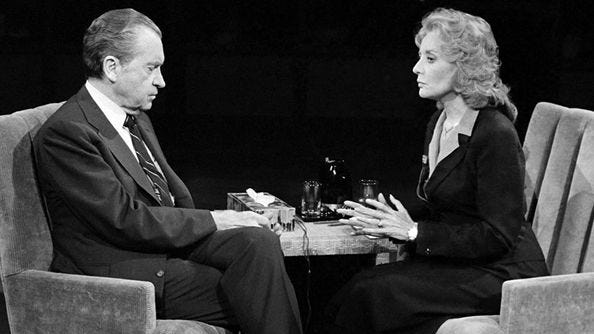
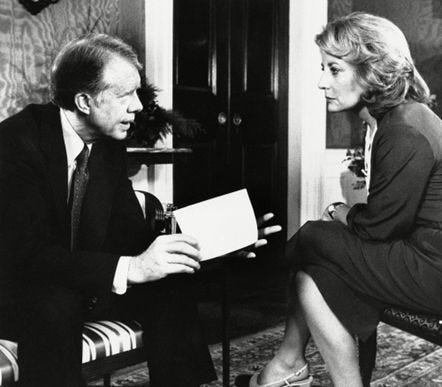
I asked my friend Anahata if bids for connection translated into British culture.
“The Brits are renowned for making friends and connecting over the weather,” Anahata shared. “We endlessly discuss the downpour or the one that is coming. We lament and laugh and get to know what is in the heart of the passerby by commenting on the weather. These are bids for connection. When I connect with someone, the light bounces back and forth, which is nectar. I may never see them again, but when two souls touch, we are forever changed. The community of my heart is very happy in that moment.”
On Sunday, I was invited by my yoga teacher to “SOL DANCE An Ecstatic Movement”— over 200 people in a free-form kinesthetic tribal gathering — an event I would have never dreamed of attending (I was twice the age of the older participants).
I held to my New Year’s vow to embrace every invitation to engage with humans. A second friend wanted to join me there, so boom-boom, two units of Bondo were added to my galvanic solution. Make that three units when I learned my second friend was turning 65 the next day, and I insisted on taking her to lunch.
Every woman reading this thinks, “Bruce, why are you being so scientific? Just go with the flow!”
I’m curious about the alchemy of love, especially when, according to Axios, our culture produces more lead than gold. Plus, I’m “actively engaging” my grief process, which means taking action.
By Gottman’s measure, Bondo is formed through conversation, akin to “call and response.”
In music, call-and-response works like a conversation. A phrase of music serves as the “call” and is “answered” in a vocal line or instrumental riff. Here are some examples:
Lipps, “Funkytown” — the bleeping keyboard riff answers each vocal.
Marvin Gaye and Tammi Terrell, “Ain’t No Mountain High Enough” — The duo call and respond in a passionate musical conversation.
Or, go to the undisputed King of Call and Response, the “Hi dee hi dee hi dee hi” in Cab Calloway’s “Minnie the Moocher.”
Cab Calloway, "Minnie the Moocher," Blues Brothers
If you grew up in the African-American church, the call and response of gospel music form an inseparable part of the experience. Responsive chants and ghazals exist in every culture.
You may have felt the call-and-response rhythm at your dinner table. Here’s a lively scene from “Seven Superpowers,” a book I co-wrote with Dr. Maria Gilmour, who described a typical family dinner growing up:4
“Maria, how was school?” my dad asked.
“My turn, my turn. I want to go first,” Mikey blurted.
“The coach made us run extra laps,” I said, “and two kids got in a fight at lunch.”
“What about me?” Mikey tried again. “I went with mom to the store.”
“Fight any dragons today, Dad?” Karen chirped in.
“Brian?” my mom prodded.
“I dunno, school.” Brian picked up his air guitar. “Baba-baba-bahh… Stevie Ray Vaughn, “Pride and Joy.” Learned the opening riff.”
“Wonderful,” Mom beamed, always stressing the upbeat.
“My turn, my turn,” Mikey insisted.
Free-flow, unfettered relating is not the norm in most childhoods and relationships. In Karen’s growing up, it was dangerous to “talk back” to an adult. I asked her once how it is that she revels in Bondo:
Bruce: “Karen, you’re like Ms. Bondo. How is that?”
Karen: “My mother was hardly attentive. I spent the first year of my life in the crib while she took care of my sister. And my parents fought constantly. It’s a mystery.”
If Bondo is a substance, how is it cultivated?
Philosopher, author, and scholar Jacob Needleman focused on the “cultivation of being.” Cultivation of being is interchangeable with Aivanov’s energetic substance, Reshad’s knowing soul, Rumpelstiltskin’s alchemical gold, and Bruce’s Bondo. Needleman writes:
The effect of advancing technology… has placed the satisfaction of desire above the cultivation of being.
The deep meaning of many rules of conduct and moral principles of the past — so many of which have been abandoned without understanding their real roots in human nature — involved the cultivation and development of the uniquely human power of attention, its action in the body, heart, and mind of man.”
Reshad shared how a visitor would arrive at the door at the appointed hour in aristocratic England and place a calling card on the servant’s tray. The card would be taken to the master or missus who received you for conversation. This was a “rule of conduct.”
Do we have rules of conduct today? My current rule is to respond to all bids for connection. Needleman continues:
“To be present, truly present, is to have conscious attention. This capacity is the key to what it means to be human.”
Bondo is a “capacity,” meaning conscious attention must be built. He goes on:
It is not, therefore, the rapidity of change as such that is the source of our problem of time. It is the metaphysical fact that the being of man is diminishing. In the world, as in oneself, time is vanishing because we have lost the practice of consciously inhabiting our life, the practice of conscious attention to ourselves as we go about our lives.”5
Last night, I attended a jazz concert with one of my “grief advisors.” The “diminishing” regard for the audience experience was shocking — horrific sound, bad lighting, sloppy musicianship, and a vocalist devoid of being. Even though the tickets were expensive, I saw my companion fidgeting. “You wanna leave?” “Oh, please, yes!” And we were off.
Time appears to be accelerating.
In today’s jacked-up news cycle and digital world, bucketloads of content are getting crammed into a unit of time. In reality, time is vanishing. Despite millions of voices on social media, our political conversation has boiled down to two viewpoints. We problem-solve by bullying, ghosting, subverting, and even genocide. If we can’t hang in the nuance, how can we inhabit Bondo — the space in between?
Bondo lives in the nuance — between lover and beloved, yin and yang, and God and human. It can’t be reconciled as black or white or sampled as a one or a zero. Bondo is where love and relationships are born.
The lie of Bondo is that it comes in a jar, but it is a living substance formed each moment, like bees making honey.
Karen and I were making honey, but was our relationship magical?
Magic results from work. This meant we both had to stretch and embrace each other’s reality. Importantly, I was forced to abandon my sacred cows because Karen was milking the Bondo that mattered.
Deke Slayton wrote a letter to my dad, a high-fidelity pioneer, inquiring about buying Sherwood electronics.
https://www.axios.com/2021/07/25/american-society-friendship-crisis
https://www.gottman.com/blog/the-magic-relationship-ratio-according-science/
https://sevensuperpowers.com/
https://www.awakin.org/v2/read/view.php?tid=1090







